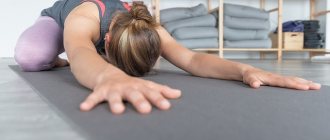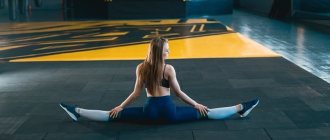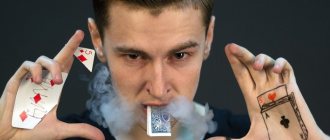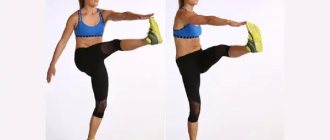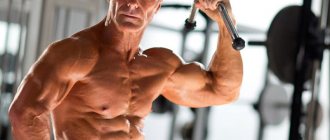Hello ladies and gentlemen!
Today I’ll talk about training the human vestibular apparatus and recommend balance exercises that develop coordination of movements. Our vestibular apparatus is a complex organ that orients the body in space. Thanks to it, we can perform complex movements automatically, without even thinking about how to perform them. They happen by themselves, naturally and harmoniously, especially in a young person, and not always harmoniously in an older person.
Balance training is important for maintaining health and increasing the length and quality of life. And these are not empty words. It develops dexterity and balance, which are often needed in everyday life. And without straining you can remember exactly when you need them. I won't even list these cases.
So think about your health and find 10 minutes during the day to do the workout I'll talk about below.
The vestibular apparatus is an organ that perceives changes in the position of the head and body in space and the direction of body movement in vertebrates and humans
What is coordination?
Coordination is the ability that allows you to perform coordinated work of individual muscle groups at the same time.
All movements are made through signals sent by the brain to our body. In the case of uncoordinated work of the central nervous system (CNS), the body receives distorted signals or does not receive them at all.
There are many reasons for this:
- exhaustion of the body;
- consumption of alcohol and drugs;
- brain injury;
- sclerotic changes;
- muscle dystrophy;
- development of Parkinson's disease;
- suffered a stroke;
- catalepsy is a rare phenomenon, expressed by weakening of muscles as a result of strong emotions.
Poor coordination is dangerous and can lead to serious injury. In addition, poorly developed coordination is not necessarily associated with the course of any disease.
If you want to test your coordination, there is a simple test :
- While standing with your eyes closed, you should try to connect your toes and heels.
- Sitting on a chair, you need to make rotational movements with your right leg clockwise, while simultaneously drawing a symbol in the form of the letter “b” with your right hand.
- Being in any position, you need to make stroking movements on the stomach, clockwise, with one hand, and tapping movements on the head with the other.
If all tasks are successfully completed, we can conclude that everything is in order with your coordination. If you encounter any difficulties, do not despair, it can be fixed.
How to practice at home correctly
Developing the vestibular apparatus means making the child strong, agile, and healthy. The exercises are not very difficult, more like games. Here's how, for example, in the cartoon beloved by all kids
Home Study Rules
- You should be guided by the child’s condition when training the vestibular apparatus. If you experience discomfort, the exercise should be postponed.
- Balance and coordination tasks are not performed after meals. Somersaults, flips, and jumps can disrupt the digestion process. An hour should pass after eating.
- The first tasks will be simple, gradually changing. The duration of the exercises is small at first, then increases.
- Exercises performed incorrectly can cause childhood injury. Parental supervision is required.
- A developed vestibular system is useful in everyday life. In an emergency situation, body control and coordination are indispensable.
What does it depend on?
Coordination is involved even in everyday tasks. It depends on how strong the connection is between the body and the brain, which proposes movements and, at the same time, exercises control over them.
The part of the brain that is responsible for sending the message to action is called premotor, and the part that is responsible for its implementation is called motor. These signals are sent to the parietal lobe. Having received the information, the area responsible for movement sends commands to the muscles of the arms, legs, etc.
When performing certain movements, the brain receives information from the nerve endings of muscles and joints about their condition and, if necessary, reflex balance mechanisms are activated, due to which the necessary changes occur in the muscles, and the cerebellum regulates all this.
The muscles contain sensory fibers, thanks to which the degree of their tension is measured, after which a corresponding signal is sent to the brain.
The result of any complex movement involving the control of all or several muscle groups invariably depends on the motor nerve fibers.
They are located in the brain and spinal column, and reach all muscles. Each of them branches off and reaches a certain group of muscle fibers (muscle nodes); they come into action when an impulse arrives from a nerve fiber branch.
The execution of these actions also depends on the information coming to them from the sense organs that control movements. However, with good muscle control carried out through the brain and central nervous system, insufficient muscle development will not allow you to perform even the simplest actions.
The components of muscles are living tissues, so their condition is directly related to the nutrients and oxygen coming from the blood and the removal of waste products. But besides this, physical activity plays an important role, which is necessary for the proper functioning of all muscle groups.
Manifestations of apparatus weakness
Overload of the motor coordination system is caused by prolonged rotation of the body, numerous pitches and rollovers. The result is reactions: decreased blood pressure, slowed pulse. There is pallor, nausea, cold sweat, and blurred vision. The above phenomena are a consequence of increased load. A weak vestibular apparatus provokes unpleasant sensations even with minor changes in body position.
Manifestations of poor performance of the coordination body:
- Using land (water) transport causes nausea, vomiting, and dizziness.
- Watching fast moving objects leads to a feeling of weakness and loss of orientation.
- Sudden body movements cause unpleasant physical sensations.
- Weakness of the balance system can be mistaken for a manifestation of a serious illness. The cause of the condition is the lack of regular adequate exercise. The body can be made more resilient.
When is the best time to develop?
Coordination develops from childhood, when the child begins to independently hold his head and roll over onto his stomach. Development continues until age 18. With the right activities - visiting various clubs and sports sections - it will improve with age.
Even if, as an adult, a person gives up classes and stops developing this ability, the “muscle memory” function will not allow him to be clumsy. It is for this reason that it is important to accustom a child to constant sports activities and develop coordination from childhood.
Gymnastics, tennis, football, roller skating, skating and cycling contribute to the development of coordination ability. The most suitable age for starting exercises is considered to be from 2 years . For those who have missed the time, there are a lot of exercises that help with proper coordination. It is important to perform them regularly, learn each element separately and repeat it many times.
Exercises to develop coordination
Below we will describe exercises that can be performed without the use of specialized exercise equipment. Daily simple exercises will not take much time, but will help you achieve good results. In addition, these exercises have a beneficial effect on many organs.
If you are too lazy to read or it’s easier for you to perceive visually, then here is a useful video that contains basic exercises for the targeted development of coordination.
Pole with ropes
This exercise helps to relax the arms, shoulders and relieve tension in the neck.
You need to stand up straight and place your feet at shoulder level. You can imagine the torso as a pillar, and the arms as ropes that are tied to it. When performing the exercise, your hands should be completely relaxed. You need to turn around an axis and fully transfer your body weight, gradually increasing speed.
Heron
When performing this exercise, you need to lean on one leg. It has been practiced for centuries in Eastern medicine and has a positive effect on the immune system, since the channels of six important internal organs are located on the feet. In addition, it prevents the development of varicose veins. It must be performed without shoes.
You need to lean on one leg, and raise the other so that the thigh is parallel to the floor (if possible, higher). If it is not possible to raise your leg high, stop at the maximum possible height.
Extend your arm with the same name as your raised leg in front of you, without fully extending it. Keep your other hand in a lowered position. Once you have reached the desired position, try to maintain your balance with your eyes closed.
Video clip
This exercise has a positive effect not only on the coordination system, but also on the entire body. It helps strengthen the spinal muscles and improves blood circulation. This exercise requires a flat surface. Initially, the exercise may cause discomfort, in which case you can use a mat.
In a sitting position, pull your legs towards your body, clasping them with your arms. It is necessary to round your back as much as possible. With a quick movement you need to lean back, roll over onto your back and return to your original position.
Hammer
The hammer exercise also has a beneficial effect on the spine, more precisely on its upper part. It is quite simple, but it is important to know when to stop. When performing this, crunching sounds may be heard, but there is no need to worry about this.
You need to lie down and clasp your shoulders with your hands, then slightly raise your upper body and begin to lightly “tap” your back on the floor.
Sphinx and Cobra
This exercise allows you to develop a good reaction and has a positive effect on the spine.
It is necessary to lie on your stomach and raise your upper body, in this case your forearms act as a support, they should be parallel to each other. Lower your shoulders, point your toes, look ahead. This exercise is called the Sphinx.
Now let's move on to Cobra. We remain in the same position as when performing the Sphinx exercise. Gradually rise up on your hands, while your spine should arch more strongly. To achieve the best results, you must perform these exercises together.
Germ
This exercise rounds the back as much as possible after strong backbends of the spine. It has a beneficial effect on the digestive organs and fights salt deposits.
You need to take a sitting position, with your legs underneath you so that your knees are close. Lower yourself forward and try to round your back as much as possible. Your arms should clasp your knees and be extended forward.
Crunches
The exercise is known to those who practice yoga. It is beneficial for the back and spinal region, and is practiced for the prevention of rheumatoid pain. Constant practice helps to increase flexibility and mobility of the spine, strengthens the nervous system, and can even reduce abdominal girth.
You need to lie on your back, with your arms at an angle of 90° to your body, and your knees bent. As you exhale, you need to twist to the right and left. At the same time, your shoulders should remain on the floor. You can stay in the twisting position for some time, depending on the body’s capabilities.
Tilts
This exercise helps strengthen the lumbar spine and stretches the tendons.
In a standing position, spread your legs as far as possible and extend your arms. Maintaining this position, lean to the left. Fix the position and do 3 cycles of inhalation and exhalation, then return to the starting position. Do the same, leaning to the right.
Now proceed to bend down, touching your ankles on the opposite leg with your hands. At the same time, you need to keep your other hand extended upward and look at it.
It is necessary to complete 3 cycles, and then move on to the other leg. After completing the exercise, it is recommended to bend back.
